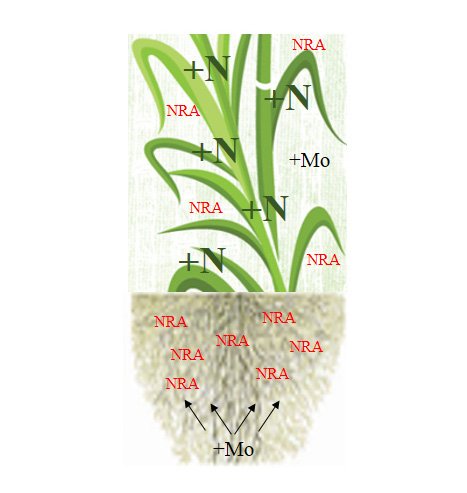Nitrate Reductase Activity and Nitrogen and Biomass Accumulation in Sugarcane under Molybdenum and Nitrogen Fertilization
13/May/2019
ABSTRACT Prior research on sugarcane showed increment of productivity following molybdenum (Mo) fertilization and some indication of the potential role either on nitrate reductase activity (NRA). However, this increment can depend on sugarcane variety and nitrogen (N) fertilization. This study aimed to evaluate the effect of Mo fertilization on Mo uptake, on NRA, nitrate (NO3–-N), and ammonium (NH4+-N) contents in leaves and roots of sugarcane, and the accumulation of N and biomass across two sugarcane varieties (RB 867515 and RB […]
Sugarcane Root Development and Yield under Different Soil Tillage Practices
06/Feb/2019
ABSTRACT New strategies for sugarcane production have been very important since the incorporation of ethanol in the Brazilian energy mix in the early 1970s. Prior to planting sugarcane, the soil is prepared, and this process can affect root development and, consequently, sugarcane production. This study was conducted in an area of sugarcane crop renewal in the Cerrado biome (Brazilian tropical savanna), with the objective of identifying which tillage system generates the better root development and improved yield in sugarcane. The […]
Normal nutrient ranges for sugarcane by the methods ChM, DRIS and CND and critical level by reduced normal distribution
01/Dec/2013
There are several interpretation methods for foliar nutrient analysis, and the critical level or nutrient sufficient range described in the literature are the most commonly used. However, an inclusion of methods that determine the normal nutrient ranges for specific regions (sites) can increase the efficiency of interpretation. The objective of this study was to compare normal nutrient ranges for sugarcane cultivation, determined by the methods ChM (Mathematical Chance), DRIS (Integrated System of Diagnosis and Recommendation) and CND (Compositional Nutrient Diagnosis), […]
Physical properties of a rhodic haplustox under two sugarcane harvesting systems
01/Dec/2010
This study had the purpose of evaluating the effects of two management types of sugarcane: harvesting of burnt cane (BCH) and mechanized harvesting of unburnt green cane (MCH), on some soil physical properties of a dystrophic Rhodic Haplustox. The data were then compared with results for the same soil type under native forest. A completely randomized design was used, with three treatments and 20 replications. The following characteristics were determined: organic matter, aggregate stability, soil bulk density, and porosity at […]
Spatial variability of aggregate stability in latosols under sugarcane
01/Apr/2009
The spatial variability of soils under a same management system is differentiated, as expressed in the properties. The spatial variability of aggregate stability of a eutrophic Red Latosol (ERL) and a dystrophic Red Latosol (DRL) under sugarcane was characterized. Samples were collected in a regular 10 m grid, in the layers 0.0-0.2 and 0.2-0.4 m, with 100 points per area, and the following properties were determined: geometric mean diameter (GMD) of aggregates, mean weight diameter (MWD) of aggregates, percent of aggregates in […]
Influence of sugarcane cultivation and clay mineralogy in physical properties of rhodic oxisols
01/Apr/2007
The current sugarcane management techniques employed involve vigorous soil revolvement with ploughs, heavy disks and subsoilers before planting. The aim of this study was to evaluate the degree of modification of some physical properties of a kaolinitic Oxisol (LVd) and a kaolinitic – oxidic Oxisol (LVdf) under sugarcane and native forest in Jaboticabal county, São Paulo state, Brazil. The experimental design was completely randomized, in a 4 x 3 split plot scheme (four managements and three depths), with four replications. […]

